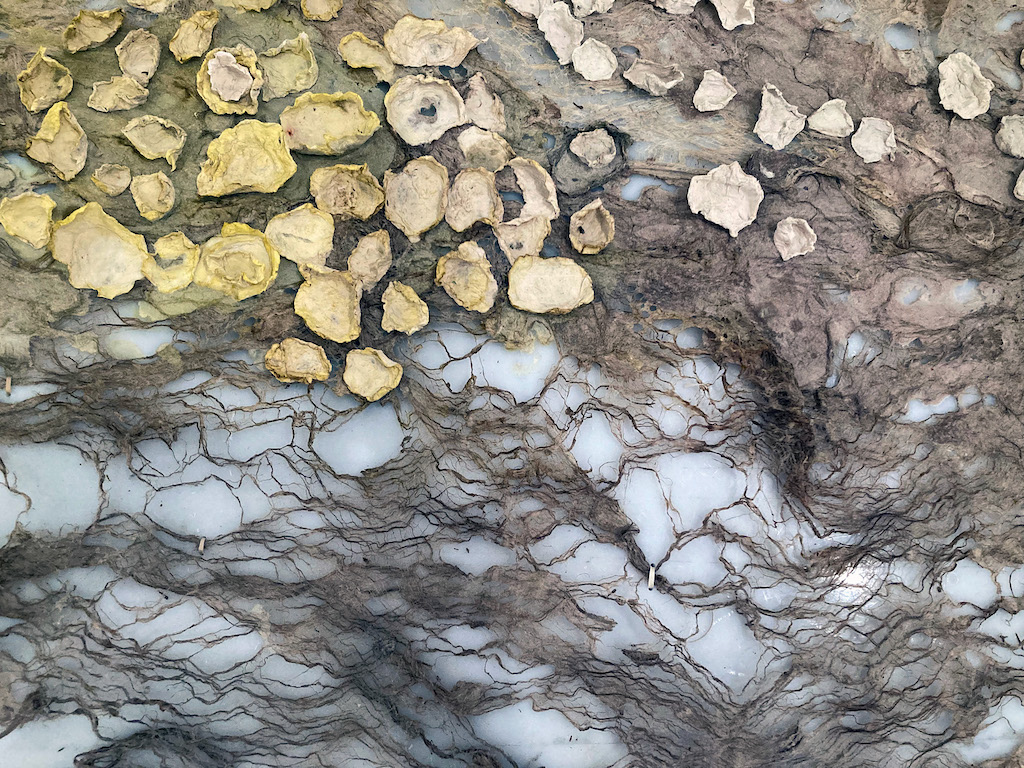Audio Description
Emily Cook, Found in the Forest, audio description, 03:43. Courtesy of Rebecca Singh.

Emily Cook, Found in the Forest (detail), 2024. Image courtesy the artist.
Audio Description – Transcript
This work is displayed in landscape orientation in a six foot tall by nine foot long lightbox with a black frame. The lower edge of the lightbox’s frame is at knee level.
This work is sculptural. It is a light to medium brown with sections that have some yellow in them. It consists of large strips of rough material similar to thick handmade paper affixed onto the white surface of the lightbox. From a distance it resembles rumpled burlap with sections of decay. The material displays fine sinewy threads stretched apart in a lacey connection along it’s horizontal plane. Some areas in the top half are more dense than on the bottom half where the lightbox surface is very visible.
The top half has clusters of round, rose petal-sized lichens in the centre. The lichens are light in colour and have edges that peel upwards. Under this is a rumpled ridge which protrudes and has a brown shelf mushroom growing from it.
The lower half of the work has less material. There are gaps between the areas of textiles, and a cluster of lichens in the bottom left.
Found in the Forest
Site Z1 on map.
In a forest ecosystem, life and death coexist in a continuous cycle, with organisms at various stages of growth and decay. This process of renewal sustains the forest, showing that life is not linear but a dynamic balance of rest and activity. In autumn, mushrooms emerge, lichens grow, at the same time that sap drains from trees in preparation for winter. The forest is always interconnected with elements encountering and supporting one another at contrasting stages of their life cycles. This hidden vitality and interdependence are central to Cook’s work, inviting reverence for the ordinary work of living.
To create this work, bark was cooked in soda ash to remove sugars and lignins, then hand-pounded with stone. The fibres were pulled into lace, with handmade paper mushrooms embedded in the delicate structure. The process required shared labour, patience, and care, aligning with the traditions of craft. It involved relinquishing control, asking for help, and forming community through collaborative-making.
Cook has described how commercial lightboxes, often glaring and disorienting, can be detrimental to the low-vision and blind community to which she belongs. By experimenting with opacity–covering the lightbox through collective labour and care–this work makes the surrounding environment more accessible and comfortable.
Reflecting on the piece, Cook shares: “This work will be up during a time when the campus can feel cold and bare. I hope this piece offers a moment of rest, reminding you that much happens beneath the surface, and that all ways of being contribute to the communities we live in.”

The Blackwood
University of Toronto Mississauga
3359 Mississauga Road
Mississauga, ON L5L 1C6
[email protected]
(905) 828-3789
The galleries are currently closed.
Facebook | Twitter | Instagram
Sign up to receive our newsletter.
The Blackwood is situated on the Territory of the Mississaugas of the Credit, Seneca, and Huron-Wendat.